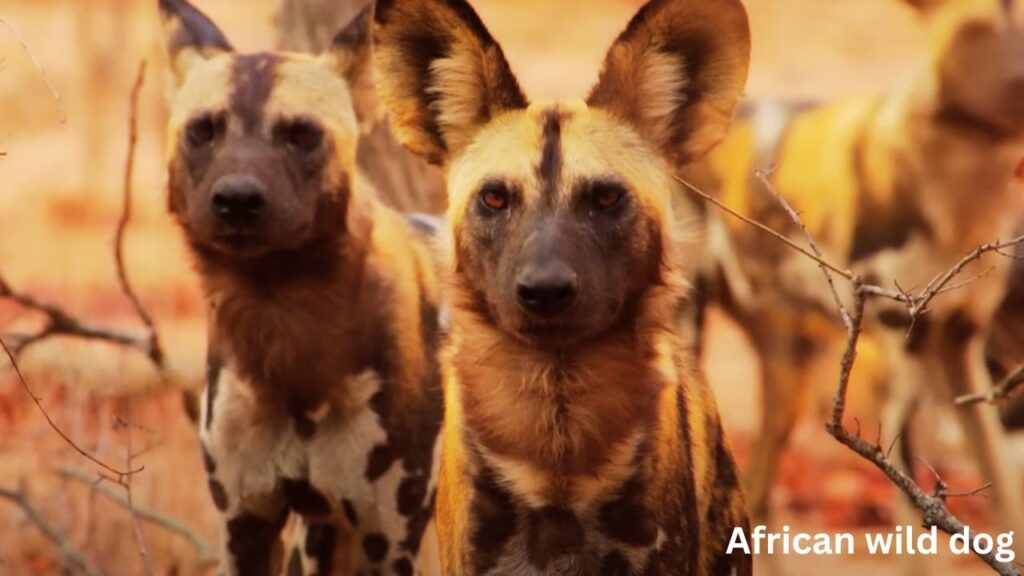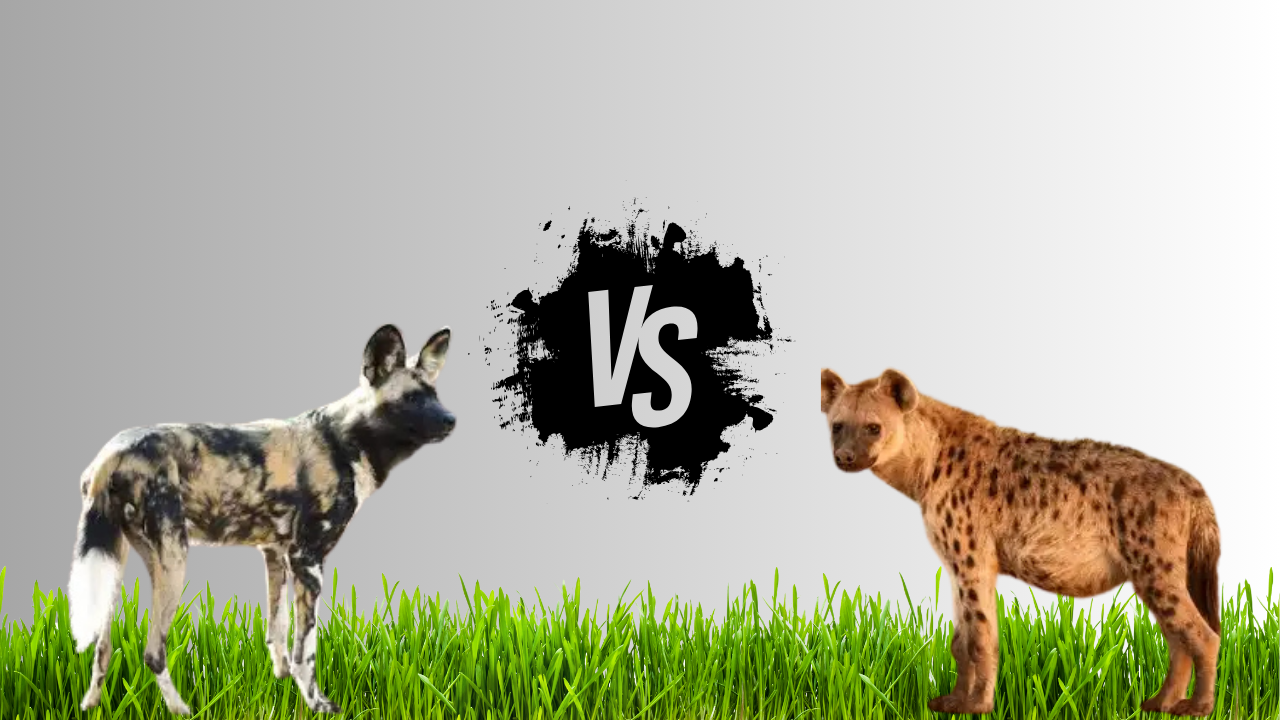When we think of Africa’s wild predators, two fascinating animals often come to mind: African wild dogs and hyenas. African wild dogs live in packs of up to 15, while hyena clans can have as many as 80 members. Exploring african dogs vs hyena reveals surprising differences in their lifestyles and survival tactics. Check out the comparison of Doberman Dog vs Rottweiler to know which breed suits your needs.
African wild dogs are famous for their teamwork and colourful coats, while hyenas are known for their powerful jaws and female-led clans. Both species are crucial to Africa’s ecosystems, but wild dogs face a greater risk, with fewer than 6,000 remaining in the wild today.
How do African wild dogs and hyenas communicate within their groups?

African wild dogs and hyenas communicate within their groups using a variety of vocalizations, body language, and scent markings. African wild dogs use high-pitched twittering sounds to communicate during hunts, helping maintain group coordination.

They also use body posture and facial expressions to signal intentions and emotions. When it comes to African Dogs vs Hyena, hyenas rely on a wide range of vocalisations, including whoops, growls, and giggles, to communicate with clan members.
These sounds help in coordinating hunts and establishing dominance. Both species also mark their territories using scent glands, signalling their presence and boundaries to other groups.
Read here: Discover the strengths of a Rottweiler Dog vs German Shepherd.
Comparison Table
African Dogs vs Hyena
Taxonomy and Classification
In this section, let’s dive into how African wild dogs and hyenas are classified. It’s important to understand their family relations because they’re actually more different than you might think!
African Wild Dogs: Family Canidae
African wild dogs belong to the Canidae family, the same family as wolves, foxes, and domestic dogs. They are scientifically known as Lycaon pictus and are the only species in their genus. These dogs are most closely related to wolves but have unique features like their large, round ears.
Hyenas: Family Hyaenidae
On the other hand, hyenas belong to the Hyaenidae family, which is distinct from Canidae. When comparing African Dogs vs Hyena, it’s important to note that the hyena family includes four species, with the spotted hyena being the most well-known. Interestingly, hyenas are more closely related to cats than to dogs, making them unique in their own right.
Physical Characteristics
In this section, we’ll explore the physical traits that make African wild dogs and hyenas so fascinating. We’ll look at size, weight, and the distinctive features that set them apart.
Size and Weight
African wild dogs are relatively lightweight, weighing between 18 and 36 kg. In contrast, hyenas are much bulkier, with weights ranging from 40 to 86 kg, depending on the species.
Appearance
The African wild dog’s coat is patchy, with a mix of black, brown, white, and yellow hues, making them stand out in their environment. Hyenas, however, sport different coat patterns, such as spots, stripes, or solid brown, depending on their species.
Distinctive Features
African wild dogs have large, rounded ears that help with communication within their pack. Hyenas, on the other hand, have a powerful jaw structure, capable of crushing bones, and a sloping back due to longer front legs.
Introduction to Habitat and Distribution
Let’s dive into the fascinating world of African wild dogs and hyenas by looking at their habitats and where they’re found. While both animals roam Africa, they have different preferences when it comes to the places they call home.
African Wild Dogs’ Habitat
African wild dogs mainly stick to open savannas and semi-arid plains across sub-Saharan Africa. Their range stretches from southern Kenya to northern South Africa, but their populations are highly fragmented. With an estimated population of only about 6,000 individuals, their habitat is rapidly shrinking.
Hyena Habitat Preferences
Hyenas, on the other hand, are far more adaptable and can be found in a wider variety of habitats. From grasslands and savannas to semi-deserts and mountains, they thrive across much of sub-Saharan Africa, and even in parts of the Middle East. Hyenas have an estimated population of around 27,000 to 47,000 individuals.
Different Needs, Same Continent
Despite sharing a continent, these two predators prefer different environments. Wild dogs, needing open spaces for hunting, are more specialized in their habitat choices. Meanwhile, hyenas, being much more versatile, can survive in dense forests, grasslands, and even rocky terrains, giving them an edge in broader environments.
Read more: Differences between Belgian Malinois Dog vs German Shepherd.
Social Structure and Behavior
When it comes to the social lives of African wild dogs and hyenas, their structures are fascinatingly different. While both are highly social animals, the way they organize their packs and clans tells us a lot about their behavior.
African Wild Dogs’ Pack Dynamics
African wild dogs live in packs that can range from 7 to 15 individuals, but sometimes, they can form larger groups of up to 40. Their pack structure is usually led by a dominant breeding pair, with strong social bonds among the members. Interestingly, males tend to stay with the pack, while females often disperse to form new groups.
Hyenas’ Clan Hierarchy
Hyenas, particularly the spotted hyena, live in large, complex clans, often numbering up to 80 members. Unlike the African wild dogs, hyenas have a female-dominated social structure where the females are larger and more dominant than the males. This unique setup helps maintain order within the clan and supports their cooperative behavior.
Cooperation and Roles
Both species rely on cooperation within their groups, but in different ways. In African wild dog packs, each member has a role during hunts, working together to chase and bring down prey using their stamina.
Hyenas, on the other hand, also hunt cooperatively, but they rely on their superior strength and powerful jaws to overwhelm prey, sometimes engaging in a mix of hunting and scavenging.
Hunting Techniques and Diet
In this section, let’s dive into how African wild dogs and hyenas hunt and what they eat. While both species are skilled hunters, they go about it in different ways.
African Wild Dogs’ Hunting Strategy
African wild dogs are exceptional when it comes to teamwork. They hunt in packs of 7 to 15, sometimes up to 40, using their stamina to tire out prey over long distances. They primarily target medium-sized ungulates, like impalas and springboks, which can weigh anywhere from 25 to 80 kilograms.
Hyenas’ Versatile Diet
Hyenas are known to be opportunistic feeders. While spotted hyenas are powerful hunters, they don’t shy away from scavenging. Their jaws can crush bones, so they’ll also eat carcasses left behind by lions or even wild dogs, making up to 70% of their diet from scavenging.
The Role of Scavenging in Hyenas’ Diet
Unlike wild dogs, hyenas are often seen raiding kills of other predators. Spotted hyenas can consume entire carcasses, including the bones, because their jaws exert pressure up to 1,100 PSI. That’s way stronger than a lion’s bite.
Interactions and Competition
When it comes to the wild, African wild dogs and hyenas are no strangers to competition. Both species share territories and prey, often coming face-to-face in the wild.
Competition for Prey
The African wild dog is a highly efficient hunter, using teamwork to chase down prey like impalas and gazelles. In fact, wild dogs have a success rate of around 70% when hunting, which is pretty impressive compared to most predators. On the other hand, hyenas, especially spotted hyenas, often rely on scavenging but will actively hunt when needed.
Encounters in the Wild
More often than not, hyenas and wild dogs come into direct competition over kills. While wild dogs rely on their cooperative hunting, hyenas, with their powerful jaws, are not easy to deter. In fact, hyenas have been known to steal up to 50% of wild dog kills, making these encounters quite intense.
Hyena vs. Wild Dog: Who Comes Out on Top?
The outcome of these encounters largely depends on the number of individuals involved. A pack of African wild dogs, which usually consists of 7-15 members, might overpower a smaller hyena group. However, hyena clans can number up to 80 individuals, making them a formidable foe when they work together.
Who Gets the Territory?
In terms of territory, wild dogs prefer open savannas and tend to move around, leaving room for other species like hyenas. Hyenas, with their larger clan sizes and aggressive nature, often dominate territory disputes. It’s not unusual for wild dogs to give up prime hunting grounds rather than engage in a lengthy battle.
Both species, while competitors, play vital roles in the African ecosystem, and their interactions contribute to the delicate balance of nature.
Conservation Status and Threats
In this section, we’ll dive into the conservation statuses of African wild dogs and hyenas. I’ll also touch on the main threats they face in the wild and how these challenges impact their populations.
African Wild Dogs: Endangered Species
African wild dogs are classified as endangered, with only about 6,000 individuals left in the wild. Their numbers are dropping due to habitat loss, human-wildlife conflict, and the spread of diseases like rabies and distemper. Conservation efforts are essential to secure their future.
Hyenas: More Stable Populations
In contrast, hyenas, especially spotted hyenas, are listed as “Least Concern” with a stable population of around 30,000. However, other species, like the brown and striped hyenas, face threats and are listed as Near Threatened due to habitat loss and human persecution. While their numbers are more stable, they still face challenges.
The Threats Both Species Face
Both African wild dogs and hyenas struggle with habitat destruction, hunting, and conflict with humans. Wild dogs often fall victim to poaching, while hyenas face retaliation from farmers protecting livestock. It’s critical for both species that we continue to promote conservation and coexistence efforts. Learn about the Anatolian Shepherd vs Kangal Dog and their key differences.
Ecological Roles of African Wild Dogs and Hyenas
Both African wild dogs and hyenas play vital roles in maintaining the health of ecosystems. They act as apex predators, helping regulate prey populations and ensuring the balance of their environments.
African Wild Dogs
African wild dogs are cooperative hunters, often working in teams of 7 to 15. Their role in hunting is essential for controlling medium-sized ungulate populations, such as impalas, which would otherwise overpopulate.
Hyenas
Hyenas, particularly the spotted species, are scavengers as much as they are hunters. Their powerful jaws can crush bones, and they often clean up carcasses left behind by other predators, ensuring that the ecosystem doesn’t become overwhelmed with decaying bodies.
Combined Impact
Together, these two species help keep their ecosystems healthy. Wild dogs reduce the number of prey animals, while hyenas clean up the remains, recycling nutrients back into the soil.
Their roles are crucial, and without them, the balance of the savanna could easily shift, leading to overgrazing and the collapse of local habitats. So, it’s no exaggeration to say that both species are key to the stability of the African wilderness.
Wrap Up
In the comparison of African dogs vs hyena, both species play crucial roles in their ecosystems. African wild dogs are smaller, weighing between 18-36 kg, while hyenas are larger, ranging from 40-86 kg. While wild dogs rely on teamwork for hunting, hyenas are known for their powerful jaws and scavenging habits. In the end, understanding the differences helps in appreciating the importance of both species in maintaining the balance of African wildlife.




